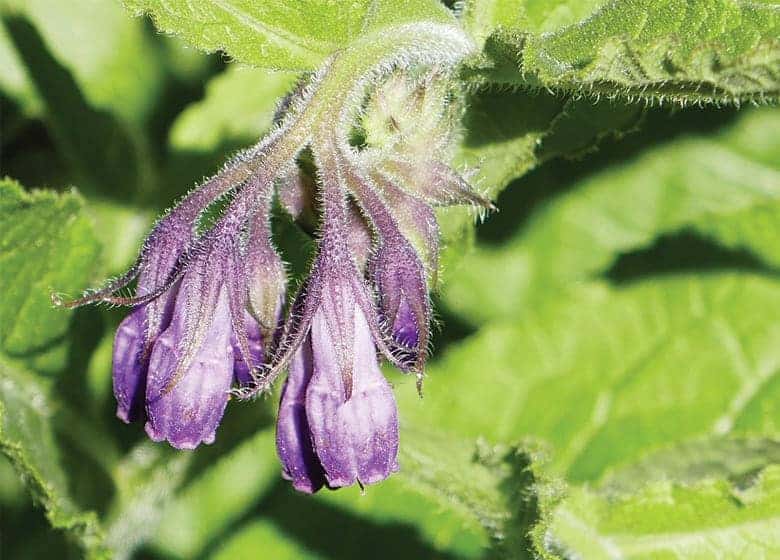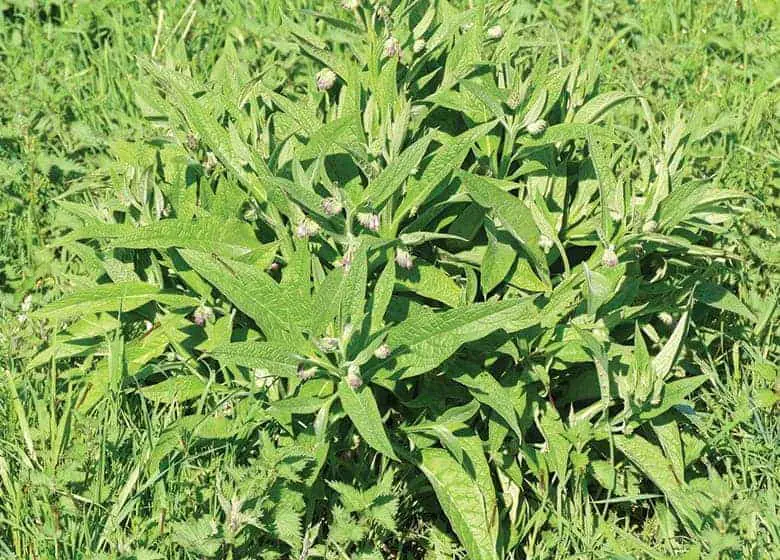Does Comfrey grow in Florida?
Yes, Comfrey will grow in Florida without a problem. It is a perennial high yield plant with long, hairy leaves that grow fast and offers gardeners many benefits.
Before planting the herb, below are things you should know about the herb.
When Do I plant Comfrey In Florida?
If you live in Florida, plant Comfrey at any time of the year except the winter. If you live in south Florida, I bet you could plant during the winter time.
However, spring and fall are the best seasons for planting.
Are there varieties of Comfrey?
There are a few types of comfrey true/common, ornamental and Russian.
The Russian variety has sterile seeds, which do not grow if they spread on the ground. Within the Russian variety, there are two main cultivars, Bocking 14 and Bocking 4
Ornamental comfrey grows differently than Russian and Common comfrey. It grows in a more spreading manor.

The roots go as far as eight feet deep into the soil making it had to dig up all the roots.
Perhaps you have dug up comfrey from one spot, do not be surprised to find it sprouting from the roots that remained inside the soil.
Comfrey leaves grow as much as 10 inches long.
The Russian type can be as tall as 4feet while the common one reaches 3 feet height.
The flowers have different colors pink, white, yellow, purple, magenta, and blue. They add beauty to your landscape together with the big, green leaves.
How Do You Grow Comfrey?

Use root cuttings to grow comfrey in partial shade. Depending on your need for the herb, it is okay to have a few in pots or several in your garden.
Considering comfrey’s large taproot and big leaves, it is advisable that you grow comfrey in the ground and or large pots.
Doing so gives it space to grow in every direction without obstruction.
If you intend to use it to make manure, then you need many plants and not a few.
Its easiest to grow comfrey from cuttings
Place comfrey root cuttings 3 inches into the soil. However, the spacing is different for each type.
With Russian, have the holes 3 feet apart while common 2 feet apart. The holes should be of 1-3gallon volume.
In case you do not have space in your backyard, plant comfreys in large, deep pots.
Because their roots run deep into the soil, up to 8 feet you would need really large pots.
Comfrey does really well in part shade. It likes the sun but not too much of it.
The herb’s leaves can survive low temperatures of -15 degrees while the roots can handle -40 degrees. It’s super cold hardy.
At the end of spring, you will see beautiful purple flowers bloom. Water the plants in hot weather but do not overdo it, as excess water will make the roots rot.
Apart from root cuttings, you can also use seeds and crowns to grow comfreys.
Comfreys grown from seeds can be invasive as the seeds disperse all over the place. It can be difficult controlling the growth. however, the Russian varietyies do not spread by seed, they only spread off of the root.
Once you have an established plant you can literally dig up the plant, cut it in half and put the other half somewhere else and this thing will still grow.
The best soil for Comfrey
Comfrey flourishes in soils that drain quickly, but it thrives in all types of soil clay, sand, and loam.
The soil should have a pH level of 6-7 and enough nitrogen.
Comfrey is not picky when it comes to soil. You will see best results when you have a soil that is rich in organic matter.
If you plan on planting right into your Florida soil, I would suggest adding some black cow compost and some worm castings into your dirt and laying down a thick layer of mulch.
How long Do Comfrey Cuttings Stay Good For?
You have just bought the root cuttings, but you are not ready to plant them immediately.
That is not a problem. Refrigerate the cuttings to keep them in proper condition. Do not use the freezer.
Do I need to fertilize Comfrey?
Adding a little bit of fertilizer is never a bad idea. You get more of a benefit from comfrey if it has lots of leaves.
Nitrogen helps plants produce green leafy growth So, the best way to fertilize your comfrey is with a fertilizer that is high in nitrogen.
However, comfrey is a fantastic nutrient accumulator, which is why it’s loved, it does not NEED fertilzer to grow but it will benefit with a little love.
Comfrey problems
Comfrey isn’t really bothered by pests and the only disease issue that you may see is rust. Your comfrey plant won’t really be bothered by many problems but there are a few problems you comfrey plant may cause you.
Comfrey has been reported to cause liver damage if consumed orally. So one problem with comfrey is that it’s poisonous if eaten. But it has many other benefits.
Comfrey can easily spread and take over if you plant it in your vegetable garden because of it’s deep and spreading roots.
Comfrey uses
Comfrey has a long medicinal history dating back to
Manure and mulching
Use comfrey to make compost manure and mulching. The leaves are rich in nutrients because the roots reach deep into the soil to extract valuable minerals.
These leaves contain various nutrients including calcium, potassium, nitrogen, magnesium, and iron. Cut them into small pieces and add at the base of plants.
You can also make comfrey plant tea, which you spray on crops or use as a liquid soil drench to provide them with rich nutrients.
Comfrey is a better mulching surface than straw and other leaves. For starters, it does not use soil nitrogen to decompose because it has its nitrogen. Second, it contains high amounts of potassium, which is useful for berries, fruit trees, and vegetables such as cucumbers, peppers, and tomatoes.
Add comfrey on a compost heap to activate heat-up for better decomposition.
Animal feed
I Don’t have cattle or chickens(yet) but the internet seems to think it’s fine, as long as it’s in moderation, to feed comfrey to your animals. I would proceed with caution when feeding it to your animals at first.
Insects definitely love comfrey flowers, not only is it feeding the insects but it’s drawing them to your garden which is a double benefit to you.
Medicinal benefits for human health
Comfrey helps treat burns, wounds, fractures, sore muscles, and bruises. It’s been known to reduce inflammation on broken bones. It’s got the nickname “knit Bone”. Its best to apply comfrey topically to get it’s healing benefits.
It contains antioxidants and vitamin C that promote fast healing of wounds. The antioxidants also prevent cell death while vitamin C fosters the growth of new skin cells.
Comfrey also boosts your immunity thanks to the vitamin C. it encourages production of white blood cells, which are responsible for your defense system.
Safety of comfrey products
Comfrey is available in different forms such as creams, salves, oils, and ointments. Use them for a short period though. Salves are useful during a massage, oils help with rashes and bites, while ointments help treat wounds.
Traditionally, people have taken oral comfrey products to treat ailments such as colitis, ulcers, and diarrhea. However, the FDA and European countries have banned them because comfrey contains alkaloids.
These chemicals are harmful and can cause liver problems, cancer, and worse even death.
Before using the herb for topical purposes, first, speak with your doctor to gauge its safety for your body. The skin absorbs alkaloids at a slow rate unlike oral consumption, which encourages fast absorption of the chemicals.
Comfrey Is Easy To Grow In Florida
- Comfrey is a perennial, fast-growing plant
- It spreads requiring space to grow, Roots reach deep into the soil
- There are three main types Russian, Common and ornamental
- You can grow it using seeds, root cuttings, or crowns. Root cuttings are your best bet.
- It requires little maintenance; cut back once or thrice a year
- Plant it during spring
- The best place to plant is the ground, not pots or buckets
- Oral usage causes health problems
- Use it for topical purposes in the form of oils, creams, ointments, or salves
- It is not prone to many pests and diseases
- It is a rich source of nitrogen
- Despite the red flags, it raises such as liver damage, comfrey presents more benefits than downsides if used in the right form.
